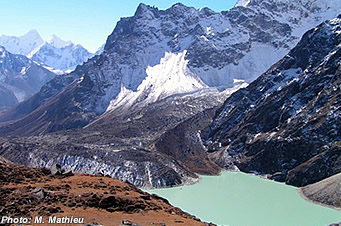 |
Nepal Himalayas Glaciers |
|
 |
Nepal Information |
|
|
 |
|
Nepal:
Climate change is real and happening now
|

|
|
Combating
the Impacts of Climate Change on Biodiversity in the Himalayas |
 |
Experts
support transect approach for understanding biodiversity loss caused by
climate change in the Himalayas
The
remoteness of the Himalayan region and its endemic poverty have isolated
it from the rest of the world, but they can't protect it from the global
ravages of climate change. The rising temperatures
are threatening a tremendous loss of biological diversity in this ecologically
sensitive region, a loss that threatens mountain livelihoods and regional
security.
Biodiversity
experts, global programme leaders and representatives of Himalayan countries
met in Kathmandu to share, network and develop future strategies to understand
climate change and to help preserve mountain biodiversity. The meeting
organised by the International Centre for Integrated Mountain Development
(ICIMOD) was the culmination of a series of workshops held during the last
fortnight on diverse aspects of climate change and biodiversity in the
Himalayas.
At
present, the lack of basic environmental data for the Himalayan region
is so serious that the IPCC, the world's apex body on climate change, says
that the region is a 'white spot' for data. Without this data it is impossible
to develop appropriate plans for avoiding or adapting to the worst problems.
The countries of the region also voiced the urgent need for reliable data
and the need to share with and benefit from global programmes on climate
change impacts, and volunteered to collaborate as needed.
 |
Chhukung (4730 m)
| The
Himalayas are too big for any group to study the whole area, but renowned
mountain geographer, Professor Bruno Messerli, and the team at ICIMOD proposed
a solution: selecting four representative 'transects' or north-south 'corridors'
in different places from east to west, and encouraging everyone, from big
global programmes to individual researchers, to focus their efforts in
these sites under a coordinated arrangement that helps make all the information
produced available for everyone to use. |
|
Representatives of global programmes
enthusiastically supported the proposal and said that they could provide
all possible technical support.
ICIMOD
as a regional knowledge, learning and enabling centre can provide the crucial
link between international technical support and the national institutions
in Himalayan countries, and provide a platform for the links that are needed
between countries.
Typical
test sites will make use of existing protected areas, national parks,
bird sanctuaries, Ramsar sites, and World Heritage sites, covering critical
eco-regions and transboundary areas. The transects stretch across national
and international boundaries, and participants stressed that regional cooperation
was needed to tackle the problems holistically and make the most of countries'
and organisations' individual efforts.
Dr.
Andreas Schild, ICIMOD's Director General, was delighted by the willingness
expressed by Himalayan countries and global programmes to participate in
a transect approach for research and gathering data, saying: 'This is a
significant and tangible first step towards the long-term preservation
of the Himalaya's genetic heritage.'
 |
| Source:
ICIMOD, International Centre for Integrated Mountain Development , 19 Nov
2008 |
ICIMOD
The
International Centre for Integrated Mountain Development (ICIMOD) is an
independent 'Mountain Learning and Knowledge Centre' serving the eight
member countries of the Hindu-Kush-Himalayas - Afghanistan, Bangladesh,
Bhutan, China, India, Myanmar, Nepal and Pakistan - and the global mountain
community. ICIMOD is a non-political intergovernmental organisation which,
since 1983, has encouraged technical cooperation between governments in
the region and whose primary objective is to help promote the development
of environmentally sound mountain ecosystems and improve the living standards
of the mountain population. www.icimod.org
The Ramsar
Convention on Wetlands - signed in 1971 in the city of Ramsar, Iran
- is an intergovernmental treaty which provides the framework for national
action and international cooperation for the conservation and wise use
of wetlands and their resources. There are currently 156 Parties to the
Convention, with 1,676 wetland sites, totalling 150 million hectares, designated
for inclusion in the Ramsar List of Wetlands of International Importance.
Member
countries of the treaty are obliged to manage all wetlands in a sustainable
manner, promoting the wise use of all wetlands within their territory;
consult with other Parties about the implementation of the Convention,
especially with regard to trans-frontier wetlands, shared water systems,
shared species, and development; and designate wetlands that meet the criteria
for inclusion in the List of Wetlands of International Importance for conservation.
top
|
more information
|

|
| Snow, Ice, Glaciers, Glacial Lakes and Floods - Reports |
 |
| Himalayas |
 |
Snow, Ice, Glacier, Glacial Lakes and Floods Reports |
 |
|
Links |

|
 |
 |
External
link |
 |
International
Centre for Integrated Mountain Development
ICIMOD |
|
 |
 |
|
Annapurna |
|




